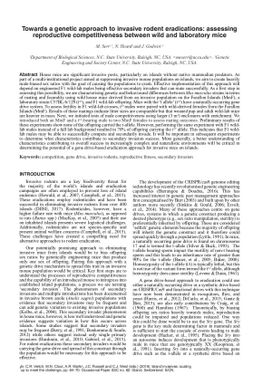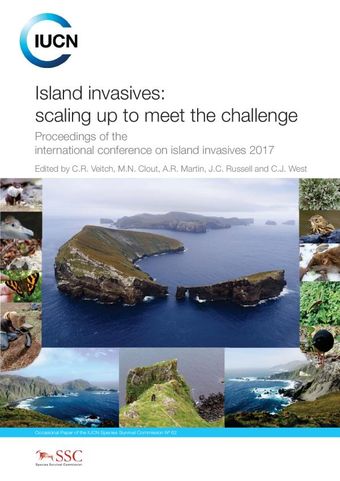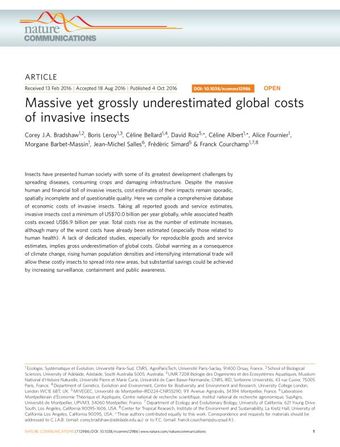Island invasives: scaling up to meet the challenge. Proceedings of the international conference on island invasives 2017
- Description:
- House mice are significant invasive pests, particularly on islands without native mammalian predators. As part of a multi-institutional project aimed at suppressing invasive mouse populations on islands, we aim to create heavily male-biased sex ratios with the goal of causing the populations to crash. Effective implementation of this approach will depend on engineered F1 wild-lab males being effective secondary invaders that can mate successfully. As a first step in assessing this possibility, we are characterising genetic and behavioural differences between Mus musculus strains in terms of mating and fecundity using wild house mice derived from an invasive population on the Farallon Islands (MmF), a laboratory strain C57BL/6/129 (tw2), and F1 wild-lab off spring. Mice with the t allele (tw2) have a naturally occurring gene drive system. To assess fertility in F1 wild-lab crosses, tw2 males were paired with wild-derived females from the Farallon Islands (MmF). Results of these matings indicate litter sizes are comparable but that weaned pup and adult wild-lab mice are heavier in mass. Next, we initiated tests of male competitiveness using larger (3 m2) enclosures with enrichment. We introduced both an MmF and a tw2-bearing male to two MmF females to assess mating outcomes. Preliminary results of these experiments show none of the off spring carried the t-allele. However, performing the same experiment with F1 wild-lab males instead of a full lab background resulted in 70% of off spring carrying the tw2 allele. This indicates that F1 wild-lab males may be able to successfully compete and secondarily invade. It will be important in subsequent experiments to determine what characteristics contribute to secondary invasion success. More generally, a better understanding of characteristics contributing to overall success in increasingly complex and naturalistic environments will be critical in determining the potential of a gene drive-based eradication approach for invasive mice on islands.
- Display date:
- 2019
- Collections:
- Secretariat of the Pacific Regional Environment Programme (SPREP)
- Publisher:
- IUCN, International Union for Conservation of Nature
- Content partner:
- Secretariat of the Pacific Regional Environment Programme (SPREP)
- Availability:
- Not specified
-
Copyright status: All rights reservedFind out more about what you are able to do with this itemThis item is all rights reserved, with means you'll have to get permission from Secretariat of the Pacific Regional Environment Programme (SPREP) before using it. For more information, please see our use and reuse page.What can I do with this item?Non-infringing useNZ copyright law does not prevent every use of a copyright work, and this item may be hosted by an international institute or organisation. You should consider what you can and cannot do with a copyright work.No sharingYou may not copy and/or share this item with others without further permission. This includes posting it on your blog, using it in a presentation, or any other public use.No modifyingYou are not allowed to adapt or remix this item into any other works.No commercial useYou may not use this item commercially.
Related items
Welcome and warm Pasifik greetings
The information on this site has been gathered from our content partners.
The names, terms, and labels that we present on the site may contain images or voices of deceased persons and may also reflect the bias, norms, and perspective of the period of time in which they were created. We accept that these may not be appropriate today.
If you have any concerns or questions about an item, please contact us.



